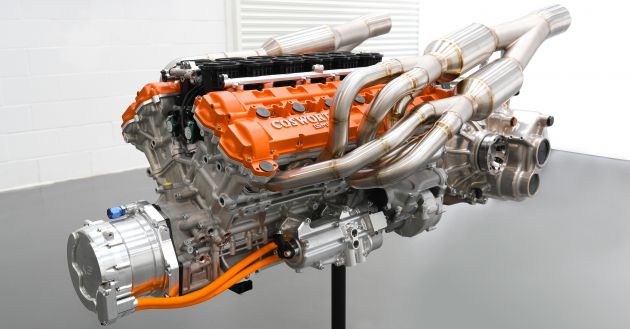GMA T.50’s bespoke 3.9L NA V12 by Cosworth detailed
Just last week, Gordon Murray Automotive (GMA) introduced the T.50 supercar, a creation which Murray himself is most proud of. That’s saying a lot, because he is the very man behind the iconic McLaren F1 supercar, but the new T.50 is born specifically to outperform that.
The big achievement here is found at the heart of the T.50 – the 3.9 litre naturally-aspirated 12-cylinder engine. GMA claims that it’s the “most engaging, characterful and driver-focused V12 engine” ever produced. While its output figures – 663 PS at 11,500 rpm and 467 Nm of torque at 9,000 rpm – are not impressive by today’s standards, it’s the fact that the engine’s 28,400 pick-up revs per second that really blows the mind. That means the car will hit the 12,100-rpm redline in less than a fifth of a second!
Achieving such extreme levels of revolutions is not uncommon in race car engines. In fact, Isuzu (among many other engine makers, really) had in 1991 developed a 3.5 litre naturally-aspirated V12 engine that made around 650 PS at 12,500 rpm, but that was a prototype engine meant for Formula One cars. The difference between race car engines and road-going ones is that the former is only designed to last several hundred kilometres, after which a full rebuild is required for it to be reliably functional, relatively speaking.
Cosworth’s 3.9 litre V12, meanwhile, is designed to be the highest-revving and most responsive naturally-aspirated engine ever fitted to a production road car (road car is the operative word here). To do this, the engine and its components must be extremely light, and light it truly is.


In order to hit the desired weight target, every single component on the car had a weight benchmark that must be met, not exceeded. The engine block itself is made from high-strength aluminium, whereas the connecting rods, valves and clutch housing are made from titanium.
Size-wise, the engine is rather compact for a V12, but Murray said it had to be very compact for the lowest possible centre of gravity. Here, reducing the McLaren F1’s 125 mm crank height was the goal, but the Cosworth team managed to mount the crank just 85 mm from the bottom of the engine.
You can clearly see the V12 engine beneath the car’s rear gullwing openings, too. Murray publicly detests engine covers, but that doesn’t mean his engines must be highly capable and ugly at the same time. For this Cosworth V12 build, Murray wanted it to be devoid of unsightly belts, so it uses gear-driven ancillaries that are carefully positioned out of sight, letting the block heads, primary exhaust manifolds and inlet trumpets take centre stage.


During the development phase, the V12 also surpassed efficiency and emissions requirements and completed plans for two engine mapping profiles. These are your driver-selectable modes – in GT mode, the engine has a 9,500-rpm rev limit, but still offers 600 PS.
Power mode, on the other hand, is pretty much self explanatory. However, GMA promises that drivers will get one of the best sounding road car engines ever made, thanks in part to the Direct Path Induction Sound engineering, which channels the sound of the V12 into the cabin.
In closing, Murray said: “To be truly remarkable, an engine needs to have the right characteristics: highly-responsive, an amazing sound, engaging torque delivery, free-revving, and it has to be naturally aspirated. For all those reasons, the engine in the T.50 was never going to be anything other than a V12.” You may read about the rest of the newborn McLaren F1 successor, here.


















































The post GMA T.50’s bespoke 3.9L NA V12 by Cosworth detailed appeared first on Paul Tan's Automotive News.
from Paul Tan's Automotive News
Read The Rest:paultan...



Post a Comment